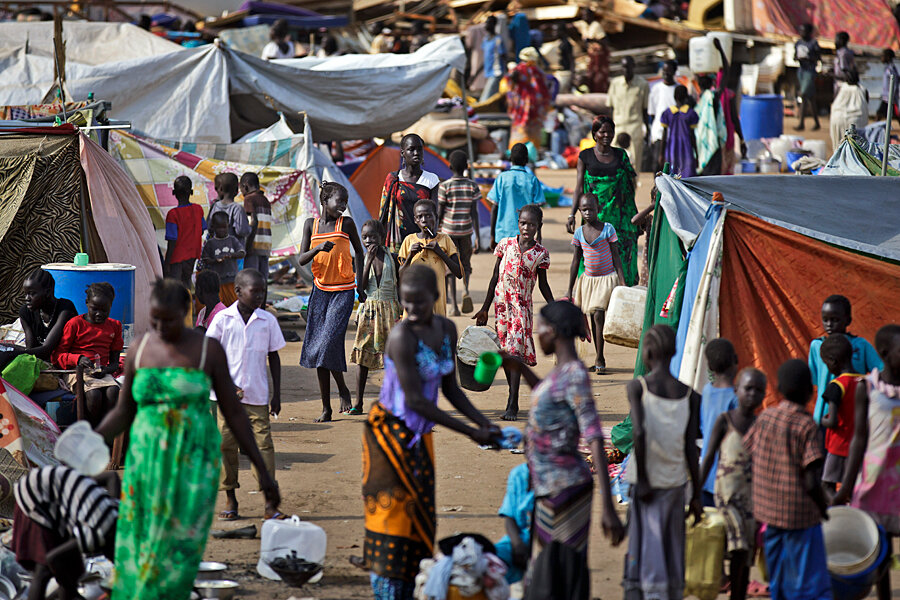Refugees in their own land: South Sudan camps breed idleness, frustration
Loading...
| Juba, South Sudan
The two UN compounds in South Sudan's capital Juba each host a crowded camp of humanity – refugees from 10 weeks of war. As fighting continues despite a flimsy ceasefire signed in Addis Ababa, these camps, or others like them around the country, are places to hear stories of the conflict.
Yet if one didn't visit these two camps, it would be hard to know that this is the capital of a country at war with itself. Traffic flows serenely. Shops are open and busy – and the only sign of unrest is an 11 p.m curfew.
Indeed, in a visit to the UN compound known as Tomping, which abuts the Juba airport, UN staff in sweatsuits jog in the early morning past long rows of gray air-conditioned offices; at noon, diplomats and peacekeepers eat nice lunches and check emails on Wi-Fi in a wood paneled restaurant.
Yet a few surreal steps away, in what is another world, some 27,000 people are crammed into makeshift shelters set so close together there is often no space to walk between. Some shelters are built beneath old airplane staircases, and others are made of tarps tied to abandoned trucks. People camp next to clogged and smelly drainage canals. Unless they brought a bed frame, everyone sleeps on a ground of hard-packed dust.
The refugees at Tomping are mostly of the Nuer ethnicity. They are too afraid to return to their houses, jobs, or schools or to venture beyond the UN walls. They came in mid-December, days after a political struggle between South Sudan's president Salva Kiir and his former vice president Riek Machar. That struggle quickly turned violent and ethnic, and pit Dinka soldiers loyal to Kiir against Nuer soldiers who follow Machar.
Across this capital riverside city, 14,000 more people live in similar conditions at the Juba 3 Camp in the UN's other base.
All told, about 850,000 people have left their homes, and 80,000 take refuge in UN bases. These internally displaced persons (IDPs), have been here for over two months after running from a wave of ethnic killings in Juba by government soldiers.
Such abuses sparked brutal reprisals across the country by Nuer militants against Dinka civilians, another ethnic group. Tens of thousands of Dinka civilians, in turn, shelter in similarly squalid camps elsewhere in South Sudan, afraid to return home in case the rebels attack again.
As the bloodletting set off in late December, Nuer men were often identified by traditional markings on their foreheads.
"It's like we're in jail," says Steven Kuon Lok, a father of nine with intricate scars carved into his face. "If I go out and they see I'm a man, they'll kill me."
The Tomping and Juba 3 camps contain walking and talking witnesses to violence that has often been so severe that reporters are blocked out. People speak of watching through windows as neighbors were shot in the streets, or of houses crushed by military vehicles. One man described being arrested and beaten for three days with dozens of others before being released.
Many of these refugees consider themselves lucky. Thousands of their neighbors or family fled to "the bush," beyond the reach of medicine or food distributions, hiding in swampy areas and living off wild fruits and river water.
Life in the camp is the result of a blast of unplanned growth, where main market streets bustle with action: venders sell tomatoes and okra, soap and phone credit. There are rows of plugs selling cell phone power. At one shelter in Tomping, someone hooked up a generator to a TV and a Playstation for kids to play video games.
Yet beyond the bustling little micro-economy, most displaced people are bored and worried and represent a well of inchoate energy, playing card games or smoking from water pipes to pass the time.
"We don't have anything to do in the camp," says Taban Deng, a 20-something who lives in Juba 3 camp. "I wake up at 8 or 9, wash my face and come and sit and drink tea."
Before the violence, Mr. Deng was a part-time college student who ran two small businesses. On the afternoon he spoke to the Monitor he said all he had accomplished that day was drinking four cups of tea while sitting in the same plastic chair.
With nothing to occupy the time of young men, many turn to drinking and fighting. Tomping's camp chairman, a member of South Sudan's parliament who didn't want his name printed for fear of his location being known, said the idleness breeds more violence among young men in a country that has had more than its share of fighting.
"This is what makes them frustrated," he said. "They see their colleagues [outside the camp] in school, but they are refugees in their own country."
Several camp inhabitants, including a policeman, said they did not want to return home for fear of reprisal by those of other ethnicity.
The camps themselves are not the product any real planning, which is part of the problem says Liny Suharlim, deputy country director for ACTED, the organization which is managing the camp. Aid agencies were caught off guard by the fighting, with many staff home for the holidays when conflict began.
"Nobody would have expected the scale of the level of emergency in the country," Ms. Suharlim says of the humanitarian situation in South Sudan, which is now described as a "Level 3" emergency, on par with the problems faced by Syria. "No one was prepared."
The camps were recently measured at 13-times more crowded than the recognized international humanitarian standard. Despite medical clinics and food distribution, there are problems with disease and hunger.







